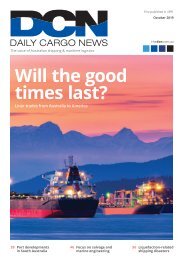DCN September Edition 2019
You also want an ePaper? Increase the reach of your titles
YUMPU automatically turns print PDFs into web optimized ePapers that Google loves.
MARITIME HISTORY<br />
Image supplied<br />
The sinking of<br />
the Wollongbar II<br />
Stephen Westfield remembers the fate of the Australian<br />
Merchant Navy ship and the bravery of the crews who<br />
served under the Red Ensign during WWII<br />
“LOOK OUT, SUB TO PORT!”<br />
These were the fateful last words of<br />
Captain Charles Benson on the bridge<br />
of the Australian Merchant Navy ship<br />
Wollongbar II on the afternoon of 29 April<br />
1943. As his ship, laden with food supplies,<br />
steamed six nautical miles off Crescent<br />
Head on the mid-North coast of New<br />
South Wales, an I-180 Japanese submarine<br />
pulled alongside it and fired two torpedoes.<br />
The projectiles hit their mark, sinking the<br />
ship and killing Captain Benson and 32 of<br />
the vessels complement of 37, including a<br />
16-year-old youth.<br />
World War II was well and truly on<br />
Australia’s doorstep. The sinking of<br />
the Wollongbar II was one of many wartime<br />
tragedies that have been largely forgotten.<br />
While our island continent was not<br />
invaded, our coastal waters most certainly<br />
were. Between December 1941 and August<br />
1943, 58 Japanese submarines sank 38<br />
merchant ships in Australian waters and<br />
hundreds of lives were lost. Due to the<br />
strict government censorship laws during<br />
World War II, most Australians were<br />
unaware of the extent of warfare within<br />
our coastal waters.<br />
With the growing threat of Japanese<br />
attacks, Captain Benson had every reason<br />
to be worried about what was to be his last<br />
Wollongbar II<br />
voyage. Earlier in the week, the Wollongbar II<br />
had spent time searching for survivors of<br />
another Merchant Navy ship, the Union<br />
Steamship Company’s SS Limerick that had<br />
been sunk.<br />
FATE OF THE “WHOLLY”<br />
The previous day in Byron Bay, the<br />
“Wholly” had been loaded with 18,000<br />
cases of butter and several tons of bacon,<br />
valuable supplies bound for Sydney. During<br />
peacetime, the 2,239-ton steel steamer,<br />
belonging to the North Coast Steam<br />
Navigation Company and traded weekly<br />
between Byron Bay and Sydney and could<br />
accommodate 150 passengers. The deadly<br />
attacks put a stop to civilian travel but the<br />
shipping line and the federal government<br />
agreed the vessel should continue to carry<br />
vital refrigerated cargoes.<br />
Captain Benson was anxious about his<br />
passage towards Sydney. What he did not<br />
know was he would soon cross a deadly<br />
Japanese submarine 200 nautical miles<br />
south and that he and most of his men<br />
would go down with the ship.<br />
Just five crew survived the sinking,<br />
clinging to a badly holed lifeboat until<br />
rescued by the fishing trawler XLCR,<br />
owned and manned by Claude Radley,<br />
and his crew.<br />
The story of the sinking of the<br />
Wollongbar II is a stark illustration of the<br />
extent of the perils on the Australian<br />
coastline and in the Pacific during World<br />
War II. The bravery of the crews who<br />
served under the Red Ensign has often<br />
been omitted in recording our wartime<br />
history, as has those who gave their lives<br />
in the Merchant Navy effort. Unescorted,<br />
unarmed merchant ships often travelling at<br />
speeds less than 10 knots, carried personnel<br />
and essential cargoes of foodstuff, supplies,<br />
ammunition and other items in short<br />
supply in those difficult times. It was the<br />
Merchant Navy’s duty to keep supplies<br />
coming at any cost, and it did.<br />
MEMORIAL FUND ACTIVITIES<br />
The Merchant Navy War Memorial Fund<br />
has embarked on a national fundraising<br />
appeal, to recognise the bravery of those<br />
crews with a project, covering new and<br />
remedial works, to the Merchant National<br />
War Memorial, in Kings Park, Canberra.<br />
The new works will include four concrete<br />
blades on a new section of pavement. The<br />
new blades (two on each side) will have the<br />
names of Merchant Navy seafarers who lost<br />
their lives in World War I and World War II.<br />
The governor-general, His Excellency<br />
General the Honourable David Hurley<br />
AC DSC (Retd), has been invited as guest<br />
of honour to deliver the <strong>2019</strong> address on<br />
October 20 and unveil the commemorative<br />
plaques. All are welcome to attend.<br />
Find more information at: www.gofundme.<br />
com/f/mnwmf-national-fundraising-appeal<br />
Stephen Westfield, board member Australian<br />
Merchant Navy Memorial Fund and chairman<br />
Young Shipping Australia NSW<br />
thedcn.com.au <strong>September</strong> <strong>2019</strong> 19
















